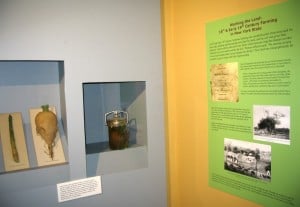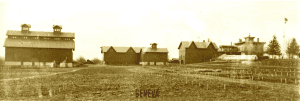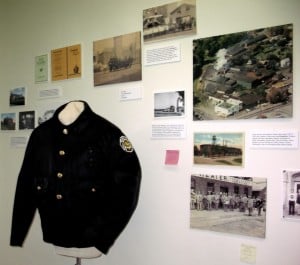Writing Exhibits
By John Marks, Curator of Collections and Exhibits
May and June are our traditional months to put up new exhibits in time for increased summer visitation. This year’s exhibits are Scientific Investigation: A History of the New York State Agricultural Experiment Stationand Geneva A-G (part one of a larger A-Z project).
I titled this “Writing Exhibits” rather than fabricating, creating, or designing exhibits. People come to museums for artifacts and photos, and for computers and electronic wizardry at larger museums, but they still learn primarily through reading. We think in panels, or posters; the main idea at the top of each panel should be short and clear, followed by images and slightly more complex (but still short) captions. The mantra I learned in graduate school was, “No one wants to read a book on the wall.” Main ideas should be kept to about 50 to 100 words at a time.
“Piece of cake!” I hear you say. However, “short writing” has its challenges. One hundred words require as much research as 10,000. Then that research is distilled and filtered into the “best stories” – what are the things upon which I should focus? In the case of the Experiment Station, it spans 131 years of scientific history that is unknown to people outside of agriculture. Do I cover all 131 years, or even do it by decade? Do I focus on some notable scientists and offend the families of those I didn’t think were notable? Do I explain all the science, or none of it?
Like any writing, there are steps in the process. Write anything, regardless of how bad it may be, to get the ball rolling. Step away and sleep on it. Rewrite, then hand over to co-workers for editing. (Any writer who says s/he has never been edited is probably lying.) Answer co-workers’ questions and in the process discover the really important ideas that you haven’t conveyed. Rewrite, and continue the process until the deadline looms.
Our main goal is to offer new information to our visitors in an easy-to-experience format. Our audience has varying levels of education, interest in Geneva, and time to spend in the museum. We try to present the “best stories” about a topic and hope it inspires people to learn more. As always, the staff is happy to talk with visitors and provide more information.
Scientific Investigation: A History of the New York State Agricultural Experiment Station will be on display until April 2014. Geneva A-G will be on display until January 2014, followed by Geneva H-N.



